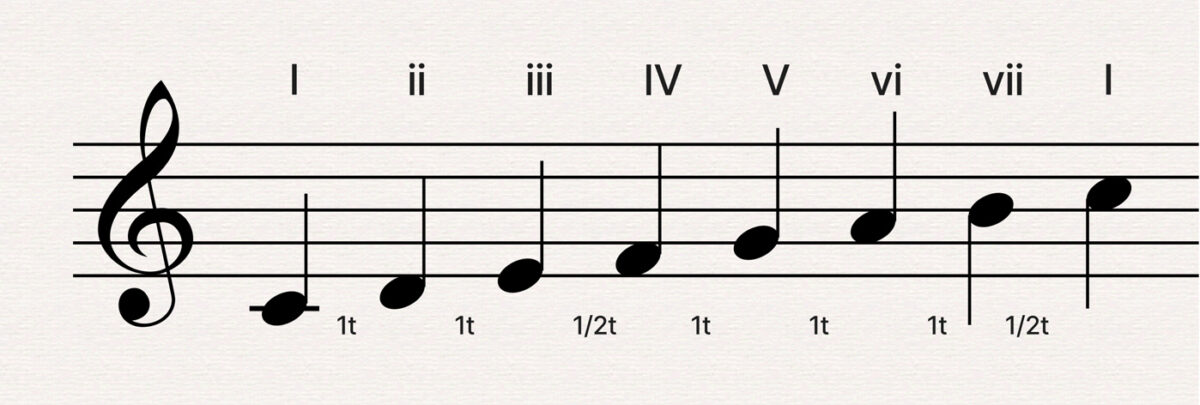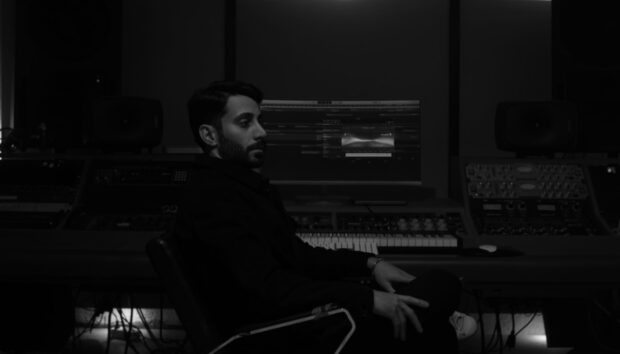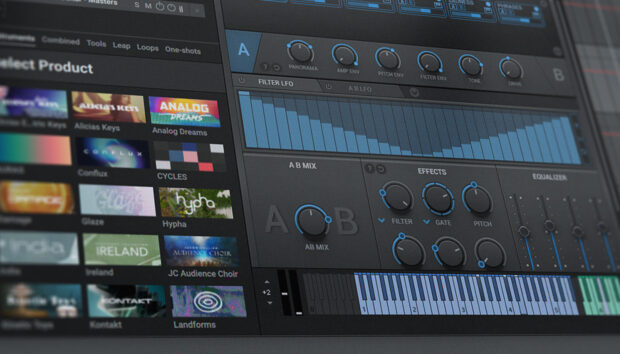
Music composition refers to arranging sounds in a way that creates a narrative over time. Music takes the listener on a journey from absolute silence to a first sound and through a whole trajectory back to silence. How we go about what happens in the middle of this has infinite possibilities, and there are no right or wrong ways to approach it.
In this piece, we’ll learn how to compose music with the basics of composition, including harmony, chords, developing musical ideas, and arrangement.
Jump to these sections:
- What is music composition?
- Understand the basic elements of music
- Developing musical ideas
- Understanding instrumentation and orchestration
- Arranging your composition
Follow along with this tutorial using Komplete 14, the ultimate suite for composers loaded with every tool you could ever need.
What is music composition?
Music composition is the process of creating original pieces of music by intentionally arranging sounds, melodies, harmonies, and rhythms. Composers who write music seek to elevate emotions and convey messages to listeners through their creations.
Composition can be a limitless game of possibilities and interactions. We can start with a single note on a piano. Let’s say, the middle C, just on its own. We can press the key once, hold it down, and wait. We can wait until the sound dies out completely. That could be our whole piece of music, and that would be ok.
Perhaps we can try something more adventurous, and instead of only playing the note once, we can repeat the same note over and over, creating a sense of pulse and rhythm. Well, that’s much more exciting compared to only hitting the one note. What about if we also chose a second note as a departure point? We could maybe play the middle C three times and then play a D note on that fourth beat. That will bring up a question that could be answered by playing a C again on that fifth beat. That’s a full circle!
We just made a tiny musical composition. Yes, with two notes. We can work our way up from here to create longer, more journeyful musical pieces.
No matter the genre, music composers create compositions that can make the listener feel will have some of the same identifying elements regardless of its style or how it was conceived. The elements I am referring to are the most overarching:
- A form that will keep things engaging and will make sense regarding its own duration. Basically, a lifespan that will feel organically justified.
- Good balance between tension and release, and the use of these two contrasting agents in ways that can evoke emotions and feelings in the listener.
- Use of textures and colors (instrumentation/production elements) that support the musical narrative.
Understand the basic elements of music
It’s important to know our way around the different aspects of music from a theoretical point of view. This gives us a broad range of tools and options to use when coming up with new ideas and expanding upon the initial bits of inspiration for a song.
Harmony
Harmony has to do with how notes relate to each other and how we can create a sense of belonging to a shared musical space with groups of notes. We often hear the term “scales,” which are a series of contiguous notes in a row that together create a musical blueprint for a sense of home.
For instance, the notes in the C major scale, C-D-E-F-G-A-B. When we play all these one after the other, and we take the time on each one of them as we go up or down, we will notice that each note makes us feel slightly different, especially in relation to the notes that are right before and after in the scale.
In this group of notes, some of them have a tendency to want to move to other notes in the scale. If we play these notes on a guitar fretboard, we’ll notice that the “distance” between the different notes in a scale is not all the same. For some, we need to move in two-fret increments, and for others, only one fret. The ones that are closer, at a single fret separation, tend to attract each other more than the others. Think of magnets and how their attracting forces increment as we make them closer to each other.
Although the reasons for this are quite different in why notes seem to want to gravitate to a certain attracting pole, we can use this metaphor to help us remember that the smaller jumps in the scale are the ones that carry most of the “attracting tension.”
In music, we call this the resolution of tension. Going from a place with a lot of momentum to a place of rest. In the C major scale context, this would take place when moving upwards from a B to a C and downward from an F to an E.
Chords
The most basic kind of chord we can build is called a triad. A triad has a root note and two stacked thirds above it.
For example, a C major chord triad consists of its root note (C), a major third (E), and a perfect fifth (G). The distinction between major and minor triads lies in the ‘distance’ between the root and the third. A major third spans two full tones or four semitones, while a minor third covers one and a half tones or three semitones. On a major scale, there are three major triads, three minor triads, and one outlier – the 7th degree, which forms a ‘diminished’ triad. It’s termed ‘diminished’ due to not only having a minor triad but also a diminished 5th, with the distance between both thirds being a minor third.
On any major scale, we will find this same configuration. Here’s laid out how it will look with the C major scale as an example:

When we move from one chord to another one, we create a chord progression.
Some of these departures from our initial place of rest feel more “far away” than others. I always like to bring up this analogy: Think of the times growing up when you would take your first solo trips on a bus, perhaps going to school or to a friend’s house nearby. Those were short trips that likely didn’t travel a big distance, and although you were moving away from home, you would still feel the ease and familiarity of your neighborhood since you knew all the different landmarks in the itinerary and would still feel a sense of “home” and belonging. This is how it feels to move from a chord from one scale to another one that is also within the scale.
Now, you might recall some of your first longer-distance trips, where you went for a getaway to a different town for a weekend or took a bus to visit family in a different state for the summer. Although that’s always a bit exciting since you are venturing to a new place and there are a lot of things to discover and be surprised by, the feeling of homesickness starts to intensify the further we go and the longer we stay away from home. This is very similar to introducing chords with notes from a different scale that we are in.
Perhaps we use a few chords that are not in the scale and take a little getaway for a while. The “further” we move away from our tonal center, “our musical home,” the stronger the sense of “relief” and release of tension we get when we return.
Establishing a sense of home takes time, but there are ways to accelerate that sense of home. If we make sure to “unpack” our musical belongings right away and explore the different shapes home can take, we can establish a tonal center and sense of home much quicker. From there, we can take more risks and push the musical envelope to other places in order to create contrast and then come back even more strongly.
Here’s a music example: if we are in the key of C major, this could look like starting on a C major chord, then going to the comforting but somewhat departing fourth degree, to the F major, and then back to C. We can top that off by going to the slightly more unsettling fifth degree, touching the G major chord, and then going back to C and feeling at ease. We can do it all over again, time after time. Guess what? You just learned how to play the fundamental chords of the blues! How cool is that?
Rhythm
Rhythm in music refers to the pattern of sounds and silences over time, creating the groove, pulse, and flow of a piece. Whenever we are creating a piece, playing chords and melodies, or even adding non-tonal textures, we can’t help but do so in the time domain.
We can use time to play with how notes interact and are presented. We can play with sustaining chords for long periods of time while faster and more “rhythmically active” melodies take the spotlight. Perhaps things happen the other way around, and a melody can be really long and sustained, with little “rhythmic” motion, while the accompanying chords play more of a rhythmic role and help propel the music forward.
There is a lot that goes into rhythm, and it’s important to understand that pretty much any aspect of music involves rhythm. We often think of drums or percussion when we hear the word rhythm, but the truth is that music is rhythm.
I encourage you to go on a whole afternoon just jamming on a couple of notes on a guitar or piano and see how much variety you can create by playing with time and how you use those few elements. When taking advantage of the possibilities we have with rhythm, we can find ourselves creating radically different sounds and bringing out a whole range of emotions by changing the rhythm of the music. Try experimenting with creating contrast by alternating the speed of an arpeggio, moving in and out of phase from the downbeats, or simply augmenting and contracting parts of chord progressions. I’ll leave it to you to discover what might happen!
Timbre
Timbre in music is the “character” of a sound, and it’s related to a combination of elements that bring that certain quality to the sonic print of an instrument.
Things can get a little blurry when we try to describe the timbre of an instrument with words that usually are not related to sound. For instance, we could say that the timbre of a French horn has a velvet quality to it. What does that mean in technical terms? Velvet is a really smooth, usually thicker type of cloth that, if we slide our fingers on it, gives us the feeling that we are touching an animal with really smooth fur. How is this related to sound? That’s hard to say, but these are the kind of words that we use to describe timbre, and it seems to work.
Some of the more scientific things you can explore if you would like to get deeper on a technical level, and that can help understand why instruments sound the way they do, are the overtone series and how different materials and ways of vibrating will produce different configurations and study the envelope of different instruments and how they impact the way we perceive them.
Let me share with you some of the timbre/instrumentation choices I made for my song “Love In A Time Warp.” This song was inspired by and written during a trip to visit a good friend who is a cellist and lives in the Tucson, AZ desert, with gigantic cacti and landscapes that felt taken out of a sci-fi movie. There was sand and dust flying in the air; the skies would turn into an indescribable orange-fuchsia blend, and the heat was so high that made us walk slower than I ever had.
I looked around and tried to use the instruments I had at hand to evoke that scenery.
- Listen to the drums: you’ll hear a vintage, dusty kind of quality paired up with the echoey slap-back delay I put on the overheads. That echo resembles the desolate and bouncy sounds of the open mountain valleys filled with cacti. The main acoustic guitar also has a similar treatment, and that comes through clearly if you listen to the opening pick-up strum.
- Listen to the background vocal layers, which, along with the doubled electric guitars with chorus, create the main riff of the song. At the end of the vocal lines, you’ll hear how they fall down, almost melted by the heat.
- The sound of the synthesizers that come in during the B sections in the song have a retro-out-of-space transporting kind of quality and help create contrast between the sections while bringing out that out-of-time feeling I described from being immersed in the dessert.
- Finally, during the final double chorus explosion in the song, I felt like I wanted to have a counter-melody to the main vocal and bring a very organic element into the mix. I also wanted to highlight the feeling of friendship and connection that sparked the trip that inspired the song. That’s why we hear a stack of cellos that outline a counterpoint during that whole section.
Of course, the meaning behind it is more personal for me than it will likely be for others who listen. But again, the sense of timbre can be a very unique and personal experience. I do hope you feel some of the good feelings from our friendship through those cello lines.
Developing musical ideas
Developing musical ideas in composition is crucial for creating depth and coherence in a piece. It allows composers to explore variations, transitions, and expansions of their initial themes, enriching the musical narrative. To get started with your musical ideas, let’s explore developing them with scales.
1. Moving within the scale
One of my favorite things to do is to explore the options we get by using just a few chords and inverting them. What does that mean? Is it like the negative of a picture? Well, not exactly. In music, and when talking about chords, inversions refer to something more comparable to rotating a picture and placing it upside-down. It’s still going to be the same picture, with the same colors and elements, but the focus of our attention will be shifted, and our perception of what is happening in front of us might be slightly different.
Let’s take the same chords we played for the example of setting our sense of home in a key. We have the I, IV, and V. If we are playing these as triads, then each chord has three notes, and therefore we can get three options for each chord. The main or default position will be the “root position,” meaning that the chord will have the note that is built upon as its lowest note. Then, we can find the first inversion, which will have the third as the bass, and then the second inversion, which has the fifth on the bass.
We now have not three chords but actually nine different options to play with. How crazy is that? There is too much to do with so little. It’s like, how many different recipes have flour and water as their main core ingredients? Too many to count.
In this example, until measure 13, I played only C, F, and G major chord triads in different inversions. From measure 14 onward, I introduced a few other chords that are not in the C major scale to show you how we can create some contrast by introducing new colors. Because we already established a good sense of home with some basic elements, the contrast of the new chords feels much stronger.
2. Moving outside of the scale
Another way to develop musical ideas is to develop our sonic choices beyond the sounds that are held within a scale. We can choose colors and sounds that belong to other scales or from different flavors that are derived from the home scale we started with.
The most common situation in pop music is to take or “borrow” notes from the minor version of the scale. To make a scale minor, we say we “lower” the third, sixth, and seventh degrees of the scale. This means we either put a flat on it or bring those sounds down a semitone or half-step.
In our familiar key of C, this would imply having an Eb, Ab, and Bb instead of E, A, and B.
The scale would then be spelled C-D-Eb-F-G-Ab-Bb
When we do this, we get some different chords to play with. The beauty of this “borrowing” is that we can change the scale to be minor or major at any given point, introducing new flavors to our composition.
A great example of this is the song “Michelle” by The Beatles. It opens the verse with a big F major chord, setting us up in what seems like a song in the key of F major, but it quickly introduces chords from the F minor scale. And then, at some point, it does go back to F major. With this, it creates a bittersweet melancholy tone around the lyrics and melody.
In this case, the melody uses notes from the minor scale as the chord changes happen. Sometimes, we can find songs that have melodies that don’t display the minor or major quality of the key that clearly, and that can be quite the opportunity to play with both chord sets and change things underneath.
If you pay attention at the end of a jazz song, many times you’ll hear the pianist play a set of improvised additional chords underneath a long sustained final note of the singer to add a little extra embellishment and drama before the song ends. That takes quite a bit of practice to do smoothly, but basically, what’s happening is that the pianist is listening to the held note and adding chords that might not be from the home key but that still work together with the melody and that way they can create a mini harmonic journey for that final statement.
3. Getting “chromatic”
The idea of chromaticism has to do with the changes in color that we get from moving on half steps; since unavoidable, if we move in contiguous half steps, we’ll be going in and out of our main scale and touching upon all the options in between. If we do that, then we are finding what we call the “chromatic scale.”
Here is an example from my own songwriting to exemplify chromaticism. I was playing with 7th chords. A 7th chord is a triad with one more third stacked on top.
If we take our C major triad, in order for it to become a “C major7,” we add the note B, which is a major third above the fifth, and the chord will be spelled C-E-G-B.
I was not in the key of C at that time. I wasn’t really thinking of any key in particular. I was just moving 7th chords up and down the fret and reacting to how they felt next to each other. I was alternating major 7th chords with minor 7th chords. I remember starting on a Gb Maj7 and then going down a half step to F minor7.
Then I took that and made it into a sequence, going up a whole step and repeating the motion starting from Abmaj7 down to Gm7. Finally, since that was feeling good, and we love balance and things that are full circle, I went back to the beginning and played the Gb Maj7 to Fm7 again. At that point, the final landing Eb chord was an absolute necessity.
In this case, the song is clearly in Eb Major. The only chord that doesn’t belong to the Eb major scale is the Gbmaj7, which is borrowed from the Eb minor scale.
Chromaticism isn’t quite happening in this situation since there is a whole step between F and Eb, which takes us back to Eb major, but it’s pretty close! And the fact that the progression departs from a Gb to F in a chromatic step makes the whole progression feel a little more colorful than it actually is.
Here are the chords of the intro and verse, which follow the same structure:
Understand instrumentation and orchestration
Instrumentation plays a crucial role in shaping the mood, texture, and overall sound of a composition. The choice of instruments determines the timbral palette and sonic characteristics, allowing composers to evoke specific emotions and convey their musical intentions.
Additionally, careful consideration of instrumentation enables composers to balance and blend different voices within the ensemble, creating harmonic and textural depth.
When thinking about orchestration and instrumentation for your composition, here are some guidelines that can help:
- Consider the sonic qualities of each instrument: Think about the timbre, range, and expressive capabilities of each instrument in your ensemble to create a balanced and cohesive sound.
- Experiment with different combinations: Explore how different instruments interact with each other and how their timbres blend or contrast to achieve the desired mood and texture in your composition.
- Keep the practicalities in mind: Consider the availability of instruments, the skill level of performers, and the logistics of performance venues when selecting instrumentation to ensure feasibility and accessibility.
If you’re composing with virtual instruments, take a look at the vast library of Kontakt instruments that will elevate your composition.
Arranging your composition
Arrangement means taking the musical ideas that were developed and imagining their song structure, instrumentation, or style. Elements such as harmony, melody, rhythm, and orchestration can be used to create a more defined version of the composition.
The goal of arranging is often to enhance the musical arrangement’s impact.
While we have an entire guide on arranging music, here are some tips that you can use to get started on your first arrangements:
- Start with a clear understanding of your musical ideas: Analyze the structure, melody, harmony, and rhythm to identify key elements that you want to preserve or modify.
- Experiment with different instrumentation and voicings: Consider how various instruments or voices can bring out different aspects of your composition and create the desired mood or atmosphere.
- Focus on balance and dynamics: Pay attention to the interplay between different parts, ensuring that each voice or instrument has its moment to shine while contributing to the overall coherence and unity of the arrangement.
Start composing music
Now that you have a better understanding of music composition, it’s time for you to pick out some of your favorite sounds and start experimenting with all these ideas. Start with a few notes from the scale, and see what you can do. Give yourself a narrow framework so you can learn to be as resourceful as you can. Then, move from there to the full scale. Start building chords with triads, and finally, add some more colors to those with 7ths or any other note you find meaningful.
There is no right or wrong. It’s a matter of using your ears and following your heart. I’ll let the incredible Claude Debussy close this with one of my favorite musical quotes:
“There is no theory. You have only to listen. Pleasure is the law. I love music passionately. And because l love it, I try to free it from barren traditions that stifle it. It is a free art gushing forth – an open-air art, boundless as the elements, the wind, the sky, the sea. It must never be shut in and become an academic art.”
And if you haven’t yet, take a look at all of the instrumentation possibilities for your compositions in Komplete 14.
For even more guides on music composition, check out these tutorials:
How to compose your first EP with Tonnerre and Komplete 14















